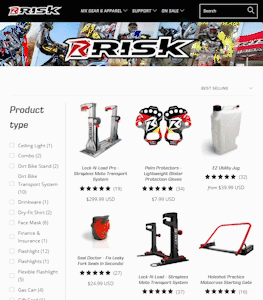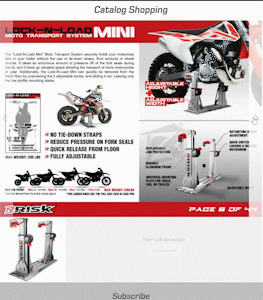Your Cart is Empty
MOTO Products
shop your way
Choose a shopping experience
Same great Risk Racing products, 3 completly different ways to shop them.
Choose a shopping experience
Same great Risk Racing products, 3 completly different ways to shop them.

Lifestyle Shopping

eComm Shopping

Catalog Shopping
MOTO TYRES
MOTO Gear & Apparel
How Much Does it Cost to Race Motocross?
July 19, 2020 12 min read

Motocross (MX) is one of the most popular motorsports globally, attracting millions of people each year across the major competitions where death-defying jumps and adrenaline pumping “bar-to-bar” action is the norm. The costs of becoming a part of this enthralling experience can, however, be prohibitive.
It can cost anywhere from $2,000 to $20,000+ to race motocross. The majority of the cost comes from purchasing a dirt bike, buying accessory equipment & gear, maintaining the dirt bike, rebuilding engines, and paying race fees.
The rest of this article will take a look at what you need to know about the sport and a breakdown of all the costs associated with it. Watch out for the section on how you can reduce the costs of racing motocross.
What Is Motocross?
Motocross is a sport where motorcycles race on grassy, muddy, or graveled tracks. It is also known as off-road motorcycle racing. The treacherous racing surfaces are an integral part of the overall experience, and the best racers know how to navigate them with ease.
The sport is regarded as rough and wild, and for millions of people worldwide, it is one of the most exciting and exhilarating sports to watch or take part in.
The Origins of Motocross
The history of MX racing can be traced to the United Kingdom. It started in the form of a motorcycle trial competition in 1909 and quickly transformed into an international competition. The first recognized motocross racing took place in Camberley Surrey in 1924. After the first few years of the sport, strict rules were created, and the world championship was established.
Today, countries like The US, Italy, Spain, Austria, Japan, and France have their unique motocross industry, with an emphasis on producing top-of-the-line technologies for their racers and making them one of the best in the world.
Racers can now take part in four major motocross competitions across various regions of the world. They include the following:
- The AMA Motocross Championship. It holds twelve major tracks across the US and runs from mid-May to late August every year.
- The British Motocross Championship. It is split into three stages that are spread out over 6-9 months.
- The Motocross des Nations. This race is hosted by different countries around the world each year, with participants from all around the world.
- The FIM Motocross World Championship. It is held in Europe most of the time, but races can occur in Africa, Australia, Asia, South America, and North America.
Of course, there is also the ultra-competitive AMA Supercross series that brings the very best riders from around the world to race on indoor tracks, but supercross is mainly reserved for seasoned pros, so let’s focus on motocross for those of you interested in getting started.

Breaking Down the Cost of Racing Motocross
As we mentioned at the start, it can cost a lot of money to participate in MX racing actively. However, a few things come together to make up these costs. The exact cost will most certainly vary from one person to another, and even for one person, the costs can change from year to year. Below are some of the things that will add to your bill when you take up motocross racing.
The Dirt Bike
The dirt bike is definitely the biggest investment you’ll need to make when you are starting motocross racing. You can get a two-stroke option for less than $2,000 (for used ones), but you’ll definitely pay a bit more for four-stroke engines. Smaller bikes for kids are also cheaper, but if you want to buy a brand new 450cc model race bike, you’ll have to budget around $8,000 - $10,000.

Maintenance and Repairs
Two-stroke bikes require regular maintenance, but repairing or rebuilding the engine will cost a lot less than a four-stroke option. Choosing a 4-stroke bike may seem like a good idea, but you have to keep in mind that it will cost more initially, and depending on the specific use, you could end up spending a similar sum compared to the two-stroke.
What Does the Maintenance for a Dirt Bike Look Like?
Maintaining a dirt bike involves regular oil and air filter changes. The chains, tires, and sprockets also have to be inspected. The maintenance for a four-stroke engine should involve changing the oil with every three rides, changing the oil filter with any of such visits.
Depending on the riding conditions, the air filter has to be changed after each ride or after three rides at most. A clean air filter and regular engine oil changes make the difference between a healthy engine, and an expensive failure and rebuild. Be a fanatic about cleaning your air filter and changing your oil, and you will be several steps ahead of the game. You should also pay attention to the valves and timing chain on a four-stroke engine. These parts can fail without notice, so you should know when to replace them.
This approach will keep four-stroke bike engines running smoothly most of the time, which makes them look like a bargain. However, if the engine takes serious damage, any maintenance “savings” you have amassed will most likely go out the window.
A two-stroke bike, on the other hand, ensures you never have to worry about valve-train. This makes them cheaper to run over time. The rest of the maintenance process is similar to what we’ve already discussed above for the four-stroke, but you may have to take the bike for maintenance after every outing, especially if you run it into the ground each time.
People only looking at the frequency of workshop visits required with a two-stroke engine may think they are more expensive in the long run. Still, when you consider the actual cost of engine rebuilds, the efficiency and cost-effectiveness of two-stroke engines become clearer.
Here is a deeper look at 2- and 4-stroke bikes and their pros and cons.
Gas Costs
Your bike and your mode of transportation to the race track will require gas. The total cost will come down to the bike you are running, the type of gas required for the transport vehicle, the size of the vehicle, and how many classes you intend to race.
An engine with a two-stroke bike uses a pre-mix while four-stroke options run on high compression race gas. There isn’t much difference in the gas costs for both engines, but 2-stokes will require the extra expense of quality pre-mix. Never forget the premix, or mess up your calculations, on a 2-stroke as the results will be catastrophic.
 Ditch the typical gas can found at your local hardware store of the general retail market. The best gas cans are actually racing utility jugs. These jugs are constructed to higher standards than most gas cans, plus they flow fuel easily and quickly with less spilling. Although most of these racing jugs operate better than typical gas cans, some racing jugs have gone to extrememeasures to design jugs with some very innovative features such as efficient and easy to use spouts, and transport mounts. Among the best on the market are theRisk Racing EZ Jugs and accessories.
Ditch the typical gas can found at your local hardware store of the general retail market. The best gas cans are actually racing utility jugs. These jugs are constructed to higher standards than most gas cans, plus they flow fuel easily and quickly with less spilling. Although most of these racing jugs operate better than typical gas cans, some racing jugs have gone to extrememeasures to design jugs with some very innovative features such as efficient and easy to use spouts, and transport mounts. Among the best on the market are theRisk Racing EZ Jugs and accessories.
Some states may have restrictions on what can be used as a “gas can”. Be sure to follow local guidelines, but an investment in a quality jug makes a difference over the course of a motocross season.
Another factor considering fuel costs is getting to and from the track. If you are transporting your bike to the track with a trailer or toy hauler, you’ll spend a considerable amount on gas hauling a big load. A good tip is to transport the bike with a small truck or add a motorcycle carrier to the back of your vehicle if it can support it.
Another common trend is to haul your bike with a well-equipment moto van or sprinter(shown above). Sure, a dedicated investment, but they are very efficient in many ways, and it is nice to have everything bundled into one easy to load and maneuverable vehicle.
Race Fees
To take part in dirt bike races, you need to pay entry fees and memberships. In the US, a class of racing costs around $30. Yearly memberships at the district, regional and national levels can cost up to $150 in total. Of course, you don’t need memberships if you don’t intend to partake in any real competitions. Still, the total race fees will come down to how regularly you want to race and the number of classes.
General Expenses
You’ll need to stay refreshed on racing days, so you have to budget for your food and drink. Putting together a picnic pack may be a good way to keep down the costs if you are only racing for a day. If you’re staying for a weekend, for example, you might have to buy food around the track.
You’ll also need to budget for camping if you are spending a few days at the tracks. Many pro riders have a campervan, RV, or toy hauler, but you could make do with a tent and other camping supplies. If there’s a nearby hotel or Airbnb, you should compare the costs of renting the room for the number of days you’ll spend near the track, against how much a well-equipped tent will cost.
Just staying at the track can be fun in itself. Some of the best families you will ever meet at also camping at the track in preparation for race day. Evenings are often spent socializing and sharing time with like-minded people.
Apart from food and accommodation, other unplanned expenses can come up. Your well-serviced bike can still be part of a crash, or you could blow a tire.
So, putting all of the above into a quick list, you will have the following costs:
- Dirt Bike = $2000 to $8000
- Memberships = $50 to $150
- Maintenance = $50 for every two races
- Engine Rebuilds = $300 to $800 for every 25 to 40 hours of using the bike
- Race Fees = $30 per class
- Gas = $10 to $30 per trip
- Miscellaneous = up to $100 - $1000+ for a weekend of racing
Even if you go with the lower end of the numbers above only, minus miscellaneous, you can see that it can cost roughly $2500 to start MX racing. If you add the miscellaneous costs, it adds up to over $3000. There’s no denying the fact that motocross racing is an expensive sport to get into.
How to Reduce the Cost of Motocross Racing
We’ve offered some tips on keeping costs down above, but if you want to further reduce your expenses, especially in the early days, there are a few things you can do. Below are some of the ways to reduce the cost of getting involved with motocross racing.
Become a Volunteer at a Local Motocross Track
Talk to many riders, and many of them will tell you that their career started from a motocross track close to them. Running a race track is costly, and thus owners are always on the lookout for ways to save money. Therefore, you should consider offering your services as a volunteer on race and practice days in any capacity at all.
With time, you’ll get to know other riders, and of course, the manager of the track. After some time, you’ll almost certainly qualify for free races on practice day and reduced entry fees on race days.
Some of the things you can do as a volunteer on the track include working the food booth, picking trash, working as a flagger, etc. Even when you think they probably don’t need volunteers, you could be wrong. It doesn’t hurt to ask. It could also be your chance to cultivate a good reputation in the industry if you have plans of making your motocross racing more than a hobby.
Find a Partner
Do you know anyone else that wants to get into motocross racing? You can save costs by pooling resources together for expenses such as driving to races together, pooling gas money, and splitting camping fees. Some share race equipment, such as tools and trailers.
Some have even split the cost of a bike and shared it by racing different classes. This can be challenging, but it has been done! If you don’t have much experience maintaining or repairing bikes, be sure to team up with a buddy who does and save expensive repair labor costs. Learn from him or her, but be sure to hold your own and help them in different ways as you learn.
If you are going to be sharing racing equipment and traveling together, be sure and pick the right friends!
Ride on Practice Days Only
If you already have a bike, you can save money by only riding on designated practice days.
It costs a lot less than racing on standard racing days, and you can ride for as long as you want. You don’t have to worry about arriving at a fixed time, or any other such rules. If you already hold the volunteer position recommended above, you’ll most likely not need to pay any fees to get a practice slot.
While out on practice day, you can challenge other riders to a race without all the pressures of a conventional race. You can make up your own rules and just focus on practicing and becoming a better rider.
Look for Sponsorships
If you already have quality motocross racing skills, you can actively seek sponsorship opportunities. Many of the companies that provide sponsorships don’t work with only professionals. All you need is to show some skill and passion and race frequently to give the sponsor on your shirt some airplay.
Even if you don’t get a place on the podium, some of the sponsors will settle for getting some eyeballs on the branding on your shirt, or bike especially if the race is on any kind of TV.

If you end up getting a place on the podium, your stock can rise a great deal. This is also true if you have a healthy social media following, where you can give a shout out to the sponsor.
The benefits of the sponsorship will vary depending on your skill level and “marketing reach,” as we’ve just mentioned above. Even if you aren’t winning races, but have a strong internet presence with specific followers that are valued by a sponsor, you can find your self getting sponsorship discounts, free product, or more depending on your reach and influence.
Be sure and follow your favorite moto brands to become familiar with their brand message and culture. Great motocross social accounts such as @riskracingmoto or Risk on Facebookwill often give you more insight and behind the scenes than their website. Knowing the ins and outs of the brands you want to be sponsored by will help you get your foot in the door.
When you do get some support, be sure to honor the agreement. These brands are offering you goods, services, or money based on the fact that you will further promote their brand. Be sure to represent yourself well and always give them a tag on your social media.
As you improve and become more popular, you’ll get even more freebies and perhaps start looking at some extra cash.
You should also consider “race contingency programs” from bike manufacturers where riders using their bikes in a race qualify for some rewards if they win the race or post a respectable result. You need to watch out for such programs during popular races that get a lot of fanfare.
Once you find a sponsorship that looks like a good fit, read the terms and conditions, submit all necessary paperwork, and sign up.
Win Some Competitions
There are few things better than being the winner of a competition in a sport you love. Regional races are your best bet to win a sizable payoutfor crossing the finish line first. You can get anywhere between a few hundred dollars and a few thousand for winning such a competition. It’s probably not enough for you to leave your day job, but you may not have to worry about maintenance fees and buying top of the line gear.
Keep Your Bike Properly Maintained
We’ve looked at some tips for maintaining your bike above. Maintenance is not something you should skimp on. That small problem you are ignoring can force an engine-rebuild or compromise other costly parts much earlier than expected.
For example, a leaky fork seal may just start as a small weeping of oil, but one jump too many and it will dump all of your fork oil causing your suspension to fail and your front brake pads to become saturated and worthless. Now you will be forced into expensive suspension and brake repairs. Maintenance on your suspension with a tool such as The Seal Doctor to prevent and fix leaks will save you hundreds in the long run.
Don’t try to cut corners and don’t run your bike into the ground before taking it to the maintenance shop. If you don’t want to follow the recommendations above, you should at least listen to your manufacturer's recommendations.
Keep an Eye Out for Bargains
Watch for deals on motocross bikes and parts. They can help you save money. You don’t have to wait until you need the parts to buy them. By that time, you may probably not find a deal. You should stock up on essential parts once you find a bargain and have some money for it. You’ll most likely save more money in the long run.
This is especially important if you take part in multiple races for the year. If you suddenly need new parts in peak season, you’ll find it difficult to land any deals. In fact, you may pay some marked-up prices, especially if you need to replace the part urgently while on the racetrack.
Also, sign up for your favorite moto brand newsletters. This is often a great place to get the latest news and product releases, but also inside deals and coupons!
Final Words
When it comes to the cost of motocross racing, many moving parts come together to make up the total amount you should expect to spend. If you already own a bike, the costs can come down to a few hundred to a couple thousand per race, considering all race-related expenses and accommodation.
If you don’t own a bike, the costs might be prohibitive for you at this point. Consider going with some of the recommendations on how to keep them down. Your love and passion for the sport will be the drive you need to get going. Once you get a bike sorted, everything else should fall in place.
Leave a comment
Comments will be approved before showing up.
Subscribe
Sign up to get the latest on sales, new releases and more …

Limited Time 10% Off
Save on your 1st order and get email offers when you join.
Eligible for first-time website purchases only. Emails may take a few minutes to process and could get flagged by email providers as junk so be sure to wait a little bit and check your junk and/or spam folders.

 UK/EU▾
UK/EU▾


































